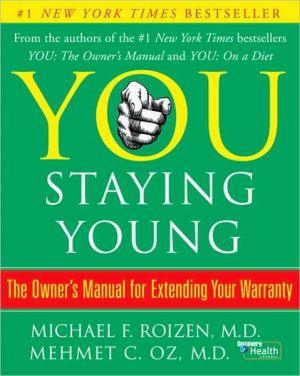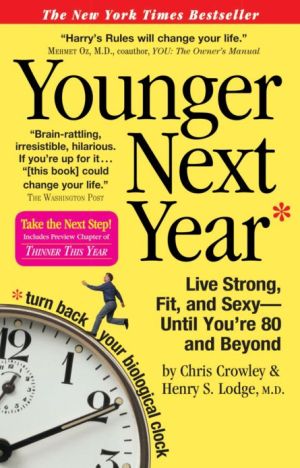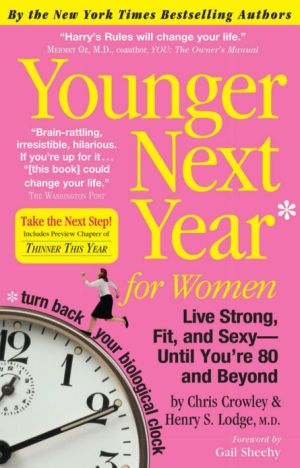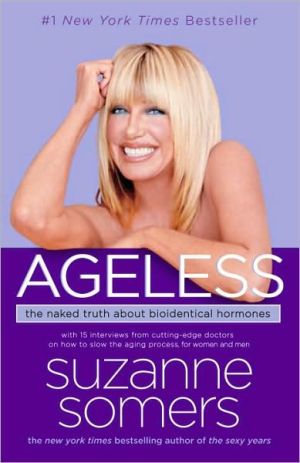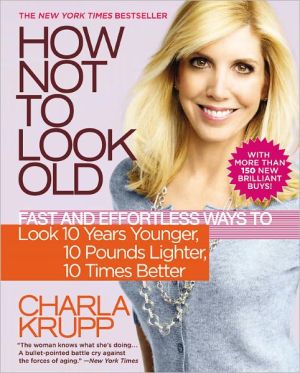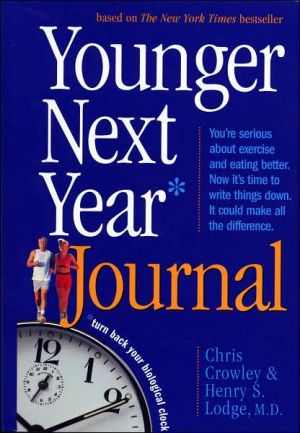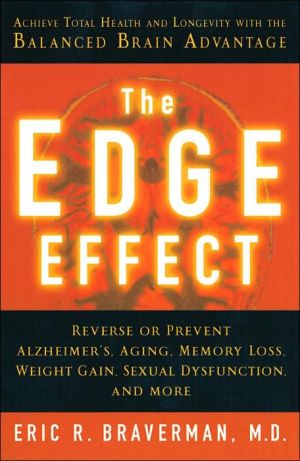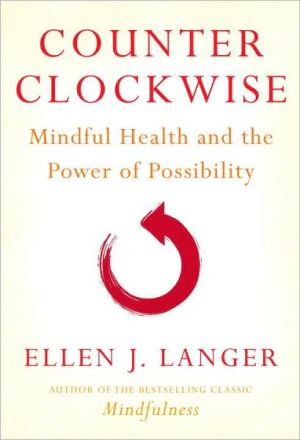You Staying Young: The Owner's Manual for Extending Your Warranty
The body is the most fascinating machine ever created, and nobody talks about it in ways that are as illuminating and compelling as Dr. Michael Roizen and Dr. Mehmet Oz. Most people think of the aging of our bodies the same way we think of the aging of our cars: the older we get, the more inevitable it is that we're going to break down. Most of us believe that at age 40 or so, we begin the slow and steady decline of our minds, our eyes, our ears, our joints, our arteries, our libido, and...
Search in google:
The body is the most fascinating machine ever created, and nobody talks about it in ways that are as illuminating and compelling as Dr. Michael Roizen and Dr. Mehmet Oz do. In YOU: The Owner's Manual they showed us how bodies work in general, and in In YOU: On a Diet, they explained how bodies lose weight and stay fit; both books have sold in the millions. Now, in In YOU: Staying Young, the doctors are going to talk to you about what happens as your body ages. As with their previous books, they've conducted tireless research and will introduce fascinating and crucial information in an unforgettable way. Most people think of the aging of our bodies the same way we think of the aging of our cars: The older we get, it's inevitable that we're going to break down-it could be in just a few ways or it could be in dozens of ways. Most of us hold this notion that once we reach 40 or so, we begin the slow and steady decline of our minds, our eyes, our ears, our joints, our arteries, our libido, and every other system that affects the quality of life (and how long we live it) . But according to Dr. Roizen and Dr. Oz, that's a mistake. Aging isn't a decline of our systems. It's actually very purposeful. The very systems and biological processes that age us are actually designed to help us when we're a little bit younger. So what's our role as part of the aging population? To learn how those systems work, so we can reprogram them to work the way they did when we were younger. Your goal should be: Die young at any age. That means you live a high quality of life (with everything from working joints to working genitals) until the day you die. Because the doctors' real goal isn't just to make you live longer; it's to allow you to maintain vibrancy throughout your entire life. The authors will tantalize readers with completely novel concepts---they're not just going to tell you that all you have to do is eat well and sleep lots. They'll explain how our bodies have evolved to ensure 50 years of high quality life, but those same mechanisms can be counterproductive as you age (it's the concept of biologic necessity, rather than just an accident; a biological process that helps you cope better when young unfortunately does opposite as you age). They'll do this by using the metaphor of a city to explain how the body works. Just like your body ages, a city does, too-especially if decisions are made that negatively impact the health of the city, or if too many resources and investments are used in the wrong areas and too few resources are used in the right areas. A once vibrant body can deteriorate if you don't take care of it. But if you revitalize, maintain, and implement new ideas, you'll keep your body at its finest. This allows you to live gracefully and passionately with a fundamentally older infrastructure. Some examples you'll see throughout the book: Your arteries are like roadways that can be clogged, blocked, or worn down after years of abuse. Your brain is like the energy grid that supplies power to the entire city-and can be knocked out here and there if you let neurological branches fall on your power lines (keys, anyone?). Your skin, in many ways, is like a city's parks and green space-contributing to the overall sense of beauty and vibrancy. Your fat? Yep, landfill. But really, the ultimate goal isn't just to keep your biological city from turning into a ghost town-to keep you from dying. The goal is to make your body top the "best city to live in" list. It's to make it vibrant, hip, to give it lots of resources and manage them well, and, perhaps most of all, to give it the ability to reinvent itself in the face of changing times. The book will be full of signature YOU methods to convey the story, including YOU Tests, YOU Tips, and visual and verbal metaphors to bring the science alive; it will be heavily illustrated in the same playful, irreverent style as the previous books. Each section of the book will introduce a theory for why we age, with a quick intro into the science that will be followed by chapters of the health issues that primarily fall under each specific theory of aging. As always, the doctors' passion for spreading awareness and promoting good health will shine through and make this a funny, educational, essential book. Publishers Weekly In their newest in the You series, physicians Oz and Roizen and a supporting cast of contributors explain why the body ages and how readers can become "anatomical puppeteers," mastering their genes, bad habits, environmental pollution and stress while igniting the body's ability to stay fit, strong and healthy. According to the authors, avoiding such major causes of death as cancer and heart disease increases life expectancy by only just under a decade. With their talent for creating vivid, humorous images (amplified by cartoon drawings), they describe 14 "major agers" and how readers can use what is known about telomeres (which look like the plastic ends of shoelaces), mitochondria (the body's energy powerhouses) and other components of body functioning to repair and rejuvenate cells. While the hefty amount of detailed information might seem overwhelming, the suggestions in the authors' "tool box" are straightforward and, frequently, simple: walking a half hour each day; consistently getting enough sleep; relieving stress with yoga, meditation and chi gong; removing toxins from the home; and avoiding accidents, for example. Perhaps most simple-and surprising-is their claim that one of the best predictors of aging is your perception of your own health. With the facts and tools laid out here, readers will be able to articulate, challenge and change those perceptions through positive action. (Oct.)Copyright 2007 Reed Business Information
Chapter 1\ Develop a Memorable Memory\ Our brains sure do have a way of messing with our minds.\ One moment, you can be spitting out the names of your entire third-grade class, the batting statistics from the 1974 St. Louis Cardinals, the color dress you wore to the eighth-grade Sadie Hawkins Day dance, or the entire script from your favorite Seinfeld episode. The next minute, you space on the name of your cat.\ Call them what you want -- senior moments, doomsday to dementia -- but the truth is that we all experience these neurological hiccups as we age. And we all wonder exactly what they mean. Some of us write them off to stress, fatigue, or some kind of neurological overload that's caused by the ogre who signs our paychecks, while others worry about whether a moment of forgetfulness means that we have a first-class ticket on the express train to Alzheimer's.\ No matter what we may think causes our decline in mental acuity, most people share a pretty big assumption about our gray matter: Either our brains are genetically determined to be Ginsu sharp for the duration, or we're eventually going to live life putting on our underwear last. That is, we believe that our genes, the very first Major Ager, completely control our neurological destiny.\ That simply isn't true.\ While many diseases and conditions have genetic elements to them, memory conditions have some of the strongest genetic indicators. For example, a PET (positron-emission tomography) scan, which records images of the brain as it functions, reveals evidence of early Alzheimer's when it identifies that the brain is misusing energy.This abnormality is caused by illness of the mitochondria (more details on this Major Ager on page 48), which is genetically determined. But the truth is that even if your genes have decided to give you a life of serious forgetfulness, you do have the ability to control those genes so your mind is strong, your brain functions at full power, and you remember everything from the crucial details of your life to whether or not you turned off the oven -- even when your birthday candles reach triple digits. Plus, we have lots of data from twin studies saying that less than 50 percent of memory is inherited, meaning that if you get a head start on the action steps we're going to cover, you can alter how your genes are expressed. In the end, genetics loads the gun, but your lifestyle pulls the trigger.\ Clearly, the brain is the most complex organ in your body. In fact, if the brain were simpler, we wouldn't be smart enough to understand it. But we are. Think of your brain as the city's electrical grid. Your brain's nerve cells, or neurons, are constantly firing and receiving messages in much the same way that power plants send signals and homes and businesses receive them. Power may originate from a main source, but the connections then branch out every which way throughout the city. Your brain functions the same way: Messages are sent from one neuron to another across your neurological grid. When those neurons successfully communicate with one another through the sending and receiving of neurological impulses, your brain can file away your memories.\ But what happens when a storm, an accident, or a chainsaw-wielding hoodlum knocks out the power lines? You lose connections, so you lose power -- maybe to a particular neighborhood or maybe to a large segment of the city, depending on which ones got fried. Same goes for your brain. If something knocks out those neural connections, then small or large parts of your brain can experience a blackout, and you freak because you can't remember that you left the car keys on the back of the toilet.\ Certainly, many things can cause malfunctions in your neurological grid. Some are acute and immediate, like a concussion arising from a brain bruise. Others are more chronic, as in the case of a genetic malfunction that can cause your power lines to be rickety so they easily fritz out. These are the ones that we're mainly going to address here.\ Your Memory: Don't Fuggedaboudit\ Part of our job as doctors is to tell you things straight up, because when we don't tell the truth, people get hurt. No sugarcoating. No BS (that really stands for no bad science). No "Win One for the Gipper" speeches. When it comes to your brain, here's a fact that's harsher than a Buffalo winter: The research shows that, eventually, everyone in America will either get Alzheimer's or care for someone who has it.\ In some way or another, we're all going to be affected by serious change-your-life memory problems. But the Gipper side of that statistic is this: Memory disorders aren't as uncontrollable as they seem, and the way to attack potential brain problems is by using your brain to understand them. For starters, here are some things you should know about your noggin:\ \ We actually experience a mental decline a lot earlier than we realize. Memory loss starts at age sixteen and is relatively common by forty. One way you can see this is through research done on video game players. People start losing their hand-eye coordination and the ability to perform exceptionally well on video games after the age of twenty-five. The fascinating part of this research isn't that you'll rarely beat your kid in Mario Kart: Double Dash; it's that even if your brain knows what to do when presented with an animated hairpin turn at 135 mph, your brain can't fire those messages fast enough to your trigger-happy thumbs. There's a natural slowing of the connection -- the power line -- between your brain and your body.\ Men and women not only differ when it comes to movie tastes and erogenous zones, but also differ when it comes to mental decline. Men usually lose their ability to solve complex problems as they age, while women often lose their ability to process information quickly. That split shows us a couple of things. One, that there's certainly a strong genetic component to memory loss. And, two, that there are specific actions you should be taking to combat that genetic disposition. While there are some places where you're naturally going to decline because of your sex, there are other areas where you're going to have an advantage. That means your job isn't only to try to rebuild the area that's breaking down but to preserve the areas that excel. But across the board, both genders lose competency in the areas in which they are weak to begin with. So women lose spatial cognition, and men suffer verbal losses. Though it's certainly not true for everyone, it may give you clues as to what areas of your brain to concentrate on as you age -- or it may help you play to your strengths. (Those with poor memory recall can use organizational skills to compensate, for example.)\ You don't have to have an elite brain to know that your three-pound organ has more power than a rocket booster. It controls everything from your emotions to your decision making, and it gives you the ability to understand why the baseball in Figure 11.1 on page 220 is pretty darn funny. But when we discuss memory loss, we're essentially focusing on three specific brain functions: sensory information (your ability to determine what information is important), short-term memory loss (quick, what's the title of this chapter?), and long-term memory loss (that's your bank of recipes, trivia, names, and every piece of information you've known, read, and stored during your life).\ \ Whether you've seen it on the news, on TV shows, or within your own family, you know how dementia looks from the outside: People forget faces, names, where they live, and information that seems -- to the rest of the world -- so easy to remember. The most frequently seen problem: getting lost on a walk home. To really control your own genetic destiny, you need to take a look at what memory loss looks like on the inside. For the record, age-related memory loss is classified in several ways. Conditions such as Alzheimer's, dementia, and mild cognitive impairment are all technically different. For our purposes, we're tackling them all together as age-related memory problems because of the similarities in how they change people's lives.\ Your Brain: Mind and Matter\ Before we crack some skulls and dive inside the brain, let's quickly look at what memory really is: Essentially, it's the process of learning information, storing it, and then having the ability to recall it when you need it -- whether to solve problems, tell stories, or save yourself on the witness stand.\ Learning begins with those power connections in your brain: neurons firing messages to one another. Your ability to process information is determined by the junctions between those neurons, called the synapses. The ability of brain cells to speak to one another is strengthened or weakened as you use them. We'll spare you all the biological miracles that take place between your ears, but essentially, the more you use those synapses, the stronger they get and the more they proliferate. That's why you may have strong neural pathways for your family history or weak ones for eighties music trivia. That also gives you a little insight into how you remember things. If something's exciting to you, then you learn it faster -- and train those synapses to make strong connections. But if the information seems more boring than the sexual habits of an earthworm, you can still learn and build those connections with repeated use.\ Problems arise when synapses lie dormant: The less you use certain connections, the greater chance they have of falling into disrepair (like losing fluency in a foreign language if you don't use it for a long time). Technically, we actually learn by weakening underutilized synapses and repairing and strengthening the synapses we commonly use. So if you cook a lot and enjoy it, you'll eventually know the recipes by heart -- and learn them faster because it's enjoyable. You build a large connecting wire, which allows for the faster flow of information. By contrast, lesser-used pathways fall into disrepair, so you lose or disable those connections. If you haven't exercised your 1970s TV trivia synapse in a long time, then you're not going to remember the name of the kid who played Bobby Brady on The Brady Bunch (ten points if you said Mike Lookinland before we did).\ To keep your memory functioning at optimal power, you'll need to focus onthree aspects of your biology.\ Your Brain. Let's peel back your scalp and look through a peephole in your head. From the toupee's-eye view, you can see that your brain has 100 billion nerve cells, and each cell receives one hundred messages per second. Yup. In the time it takes you to read this sentence, your brain cells have been doing more processing than the IRS's computer server.\ Your neurons -- the cells that transmit information -- look like mops with shaggy strings that reach out to one another, while the handles of the mops act like cables that carry the information. These neurons talk with one another with the frequency of eighth-grade girls at a slumber party; a lot of information is exchanged very quickly.\ The hippocampus, which is shaped a little like a seahorse and is buried deep inside your brain (see Figure 1.1), is the main driver of memory. (The other two memory-related areas of the brain are the prefrontal cortex, which controls the executive function of your brain, and the cerebellum, which controls balance.) Your hippocampus processes information before it is stored. It works best when you're either emotionally interested in the material or alert when you're learning about it. That's one reason why coffee may aid memory; it seems to increase your alertness the first time you learn something, which increases the chance you'll deposit it in your long-term memory bank.\ But for the purposes of aging, we're mostly concerned about what happens to the power lines within your brain. So flip on your hippocampus (or grab a cup of coffee) and remember this: There are protein fragments in your brain that sound like the name of a Star Wars droid -- beta-amyloid -- and they're responsible for gunking up your power lines like overgrown vegetation or fallen branches. They're likely responsible for causing Alzheimer's. The primary defect in Alzheimer's affects the input and output power lines of the hippocampus. Memory starts to fade. (The other physiological sign of Alzheimer's is the buildup of what are called neurofibrillary tangles. They're insoluble twisted fibers that build up inside neurons, like power lines getting crossed up and sending energy to the wrong location. These tangles influence intelligence.) Now, a downed branch here and there won't do much to disrupt the flow of energy through your entire city, but what happens when a lot of branches or shrubs or trees fall on the same part of the grid? You're out of commission.\ In general, genes control how much beta-amyloid you have. Some branches may be knocking out those notes from your course in eighteenth-century Roman history, while others may be causing you to forget to pick up the very thing that you went to the supermarket for in the first place. But your genes don't have complete control. You can alter the amount of gunk you have gooping up and weighing down your power lines by altering the expression of one of your genes: the Apo E gene, to be exact. Apo E protein acts like the power company crew that removes the branches and sap from the power lines after the storm. It sweeps through and removes the beta-amyloid so that your synapses can keep functioning and you don't lose the ability to remember how many career touchdown passes Dan Marino threw (420), or what year Diane Keaton won an Oscar for best actress (1977). Whenever we create new synapses to help our brain improve itself, some of this beta-amyloid remains behind, and the Apo E workers clear the gunk to ensure a clean connection.\ One group in the union, however, local Apo E4, sabotages the effort to restore power and even gunks up the power lines further (see Figure 1.2). Research shows that an elevated level of the E4 protein is correlated with a higher incidence of Alzheimer's. Fortunately, there are things you can do to turn down the activity of the E4 gene and allow the rest of the Apo E team to clear your power lines. Eating turmeric, which is found in Indian foods, seems to reduce expression of the E4 gene (India, by the way, has a relatively low incidence of Alzheimer's). Exercise has a similar effect.\ Your Blood Supply: While there's a strong genetic component to memory problems, we'd be remiss if we didn't address the arterial component of an aging brain. A lack of healthy blood flow to the brain is one of the other main causes of forgetfulness. Each side of the brain has a separate blood supply that looks like several large trees during winter. Between the twigs at the tips of the major branches are areas of brain that are dependent on blood from each of the surrounding trees. The area farthest from two blood-supply lines is the watershed area where we tend to have ministrokes when the branches of surrounding trees are pruned by atherosclerosis or the tree trunks themselves wither from poor maintenance (see Figure 1.3). Cholesterol-lowering statin drugs may help maintain memory by preserving tree architecture, while also reducing inflammation that ages the brain cells directly (more on arterial health in the next chapter).\ Your Neurochemicals: Nerve cells communicate with one another via neurotransmitters, chemicals that ferry information from neuron to neuron across the synapses between them. The most common neurotransmitter is called acetylcholine. When levels of this chemical fall, especially in the hippocampus (the part of the brain that controls our memory), we develop cognitive impairment. Many of the treatments for Alzheimer's are aimed at increasing the amount of acetylcholine in the brain.\ The other chemical that plays a significant role in memory is called brain-derived neurotrophic factor (BDNF, or just neurotrophins if you prefer), which works like Miracle-Gro for your brain. During infancy, BDNF helps develop nerves that help us learn, but as we get older, things like inflammation and stress can decrease its levels. Research shows that you can do things to improve your levels of BDNF, such as consuming the spice curcumin (a component of turmeric), restricting calories, doing exercise, being in love, and taking some of a class of antidepressants known as selective serotonin reuptake inhibitors, or SSRIs. Not surprisingly, you can decrease BDNF by eating high levels of saturated fats and refined sugars, as well as by not getting enough of the natural antidepressant tryptophan (sure, it's found in turkey, but there's twice as much in spinach) in your diet.\ So what's the biological effect of all this? Well, if you have serious memory-related problems, the gray matter in your brain actually shrivels faster than a centenarian sunbather. And the connections that are so important to maintaining memory get blocked and broken and detoured so that your memory function is slowed -- or sometimes lost. In the end, that can cause you to lose the power lines that go to the neighborhood of fashion trivia or to the office complex of phone numbers or to the cul-de-sac of your anniversary date.\ Luckily, as you'll see, there are several simple ways to restore those power lines, regrow those neural connections, and preserve one of the most powerful things you can pass along to the generations that follow: your memory. And your wisdom.\ Copyright © 2007 by Michael F. Roizen, M.D., and Oz Works LLC\
\ Publishers WeeklyIn their newest in the You series, physicians Oz and Roizen and a supporting cast of contributors explain why the body ages and how readers can become "anatomical puppeteers," mastering their genes, bad habits, environmental pollution and stress while igniting the body's ability to stay fit, strong and healthy. According to the authors, avoiding such major causes of death as cancer and heart disease increases life expectancy by only just under a decade. With their talent for creating vivid, humorous images (amplified by cartoon drawings), they describe 14 "major agers" and how readers can use what is known about telomeres (which look like the plastic ends of shoelaces), mitochondria (the body's energy powerhouses) and other components of body functioning to repair and rejuvenate cells. While the hefty amount of detailed information might seem overwhelming, the suggestions in the authors' "tool box" are straightforward and, frequently, simple: walking a half hour each day; consistently getting enough sleep; relieving stress with yoga, meditation and chi gong; removing toxins from the home; and avoiding accidents, for example. Perhaps most simple-and surprising-is their claim that one of the best predictors of aging is your perception of your own health. With the facts and tools laid out here, readers will be able to articulate, challenge and change those perceptions through positive action. (Oct.)\ Copyright 2007 Reed Business Information\ \ \ \ \ Library JournalMost of us fear aging itself less than the deterioration that is an inevitable accompaniment. Recent research, however, indicates that we can actively stave off much of this by properly attending to diet, exercise, and mental and social stimulation. These two titles, like Mark Liponis's Ultralongevityand Sanjay Gupta's Chasing Life, examine the current thinking in the field and outline plans for maintaining vigor well into the eighties and even beyond. The team behind the best-selling You: On a Diet, Oz and Roizen spend a lot of time describing the chemical and neurological processes of the aging body before dipping into various related topics (e.g., the 14 "Major Agers," aging myths, good sleep, hygiene, and a detox plan). Their style is nonlinear, with many sidebars and cartoon illustrations that baby boomers will find reminiscent of R. Crumb. This title is suited to perusing rather than reading from start to finish.\ Flanigan (cardiology, Univ. of Colorado Health Sciences Ctr.) and Sawyer (codirector, Heart and Health Prevention Ctr.) are more straightforward and economical in style, zeroing in on the ten most deadly diseases (e.g., heart disease) and how to elude them. Both books emphasize the importance of regular physical exercise, a diet rich in fiber and antioxidants and low in fat and processed foods, and sustained mental and social activity. Most public libraries will want to stock a few titles on increasing longevity, a big headline maker. Flanigan and Sawyer's title is the more accessible of the two based on approach, yet Oz and Roizen's latest will no doubt be a best seller, as the authors are scheduled to launch the book on Oprahthe firstweek of November.\ —Susan B. Hagloch\ \ \
